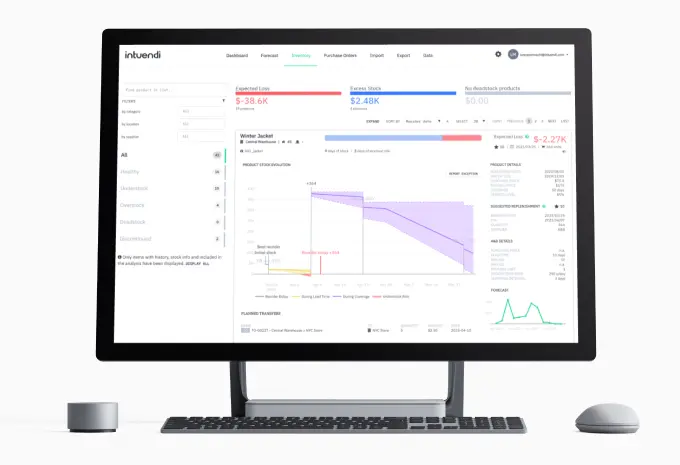Warehouse management has evolved from error-prone, manual systems to cutting-edge solutions powered by automation and intelligence. At its core, a Warehouse Management System (WMS) is more than an inventory tracker—it’s a powerhouse that streamlines every step of warehouse operations, from receiving goods to shipping orders. With capabilities like real-time visibility, predictive analytics, and optimised workflows, a WMS transforms warehouses into agile, efficient hubs capable of meeting the demands of today’s fast-paced markets.
The evolution of WMS technology has been remarkable. From paper-based tracking to barcode and RFID systems, the journey has culminated in modern platforms leveraging IoT, AI, and cloud computing. These advancements not only boost operational efficiency but also align warehouses with ever-rising customer expectations and complex supply chain dynamics.
In a competitive business landscape, a robust WMS isn’t just helpful—it’s essential. It enhances inventory accuracy, accelerates order fulfilment, and cuts costs, allowing businesses to stay ahead of the curve. By automating repetitive tasks and providing actionable insights, a WMS frees managers to focus on strategy and growth. A well-implemented WMS doesn’t just improve warehouse operations; it empowers businesses to thrive in a demanding market, delivering cost savings, improved service levels, and a clear edge over competitors.
Growth doesn’t have to translate to misaligned inventory. Keep it lean and streamlined with Intuendi.
What is a Warehouse Management System (WMS)?
A Warehouse Management System (WMS) is a powerful software solution designed to optimise and oversee warehouse operations, ensuring seamless management from the moment goods arrive until they are dispatched. Acting as the central nervous system of a warehouse, a WMS provides real-time visibility into inventory levels, directs workforce activities, and streamlines the flow of goods, enhancing operational efficiency and customer satisfaction.
A WMS excels in several key areas. Inventory management is made more accurate with real-time data on stock levels, locations, and movements, reducing stockouts and overstocks while optimising storage space. Features like batch tracking and serial number management ensure traceability and quality control, essential for industries such as food and pharmaceuticals. In order processing, a WMS automates steps from generating pick lists to managing shipping documentation, improving accuracy and fulfilment speed. It also enhances resource allocation by optimising labour, equipment, and warehouse layout based on productivity insights, reducing costs and increasing efficiency. Additionally, workflow optimisation ensures streamlined processes, such as picking and packing, by automating tasks and guiding workers to the most efficient paths, saving time and reducing errors.
By transforming a warehouse into an integrated, efficient system, a WMS empowers businesses to overcome logistical challenges, improve customer satisfaction, and achieve operational excellence.
On-Premise vs. Cloud-Based WMS
Choosing the right Warehouse Management System (WMS) often comes down to two main deployment models: on-premise and cloud-based. Each option presents unique benefits and challenges, making the decision largely dependent on a business’s specific requirements, available resources, and long-term objectives.
On-premise WMS
An on-premise WMS is hosted on a company’s own servers, providing complete control over data, security, and system management. This model is ideal for businesses with stringent data security requirements or those that prefer managing their own IT infrastructure. Its key advantage lies in customisation, allowing companies to tailor the system to meet specific needs and integrate it seamlessly with existing workflows, making it especially suitable for complex operations or niche industries. However, this model comes with significant challenges, including high upfront costs for hardware, software, and implementation, as well as ongoing maintenance responsibilities. Scaling the system to accommodate growth requires further investment in infrastructure, which can strain resources. Despite these challenges, on-premise solutions remain a strong choice for businesses prioritizing control and customisation, provided they have the resources and expertise to manage the system in-house.
Cloud-based WMS
In contrast, a cloud-based WMS (Software-as-a-Service) is hosted on the vendor’s servers and accessed online, offering a more flexible and cost-effective option for many businesses. Its primary advantages include accessibility, as it allows real-time visibility and remote management from anywhere with an internet connection, and scalability, as it can easily adapt to business growth without requiring significant infrastructure investments. The subscription-based model eliminates large upfront costs, and maintenance and updates are handled by the vendor, reducing the burden on internal IT teams. However, cloud-based systems come with potential drawbacks, such as reliance on the vendor’s security measures, concerns over data privacy, dependency on reliable internet connectivity, and possible integration challenges with existing systems.
The choice between on-premise and cloud-based WMS depends on a company’s specific needs and priorities. On-premise systems offer control and customisation but demand higher costs and dedicated resources, while cloud-based solutions provide flexibility, scalability, and cost efficiency, though they may raise concerns about data security and connectivity. Carefully evaluating operational requirements and strategic goals is essential to selecting the best option for your business.
Types of Warehouse Management Systems
Warehouse Management Systems (WMS) are available in several types, each designed to address specific business needs and operational challenges. Choosing the right type of WMS is essential for aligning with a company’s unique requirements and supporting its growth objectives effectively.
Standalone WMS Solutions
Standalone WMS solutions focus exclusively on optimising warehouse activities, making them ideal for businesses seeking a specialised system without the need for broader integration. These systems provide robust features such as real-time inventory tracking, automated order processing, and efficient workflows for picking, packing, and shipping. Their ability to be highly customised ensures they can handle complex or industry-specific needs effectively. However, standalone WMS solutions may require manual data transfers to other systems, potentially increasing administrative effort. Despite this, they remain a strong choice for companies prioritising depth and functionality in warehouse management.
Supply Chain Management Module
For larger enterprises, WMS often functions as part of a broader Supply Chain Management (SCM) system. This integration provides seamless coordination across the supply chain, enhancing efficiency and reducing lead times. By synchronising data between procurement, planning, transportation, and warehouse functions, an SCM-integrated WMS enables end-to-end visibility and better decision-making. Managers gain a holistic view of operations, allowing for improved resource allocation and quicker responses to market changes. The shared data and streamlined processes make this approach invaluable for businesses with complex supply chains.
ERP-Integrated WMS
ERP-integrated WMS solutions provide seamless connectivity between warehouse operations and other business functions such as finance, sales, and procurement. By eliminating data silos, they ensure all departments operate with accurate, real-time inventory data, enabling automation of tasks like procurement and financial reconciliation. This integration enhances cross-departmental reporting and decision-making, offering actionable insights for improved efficiency. While implementation can be complex, ERP-integrated WMS solutions are particularly beneficial for larger enterprises with diverse operational needs, as they streamline workflows and enhance enterprise-wide collaboration.
Open-Source WMS Options
Open-source WMS solutions offer a cost-effective and highly customisable alternative for businesses with in-house technical expertise. Their freely available source code allows companies to tailor features, integrate with existing systems, and adapt workflows to specific needs. This flexibility is especially appealing to SMEs with limited budgets. However, open-source systems require significant technical know-how for implementation and maintenance. While community support is available, it may not match the reliability of commercial vendors. Despite these challenges, open-source WMS can be a viable choice for businesses seeking budget-friendly, bespoke solutions.
Cloud-Based Platform
Cloud-based WMS platforms provide scalability, flexibility, and ease of use. Hosted on the vendor’s servers, these systems eliminate the need for costly IT infrastructure and offer subscription-based pricing, making them an excellent option for startups and growing businesses. Their quick deployment, automated updates, and real-time accessibility allow for streamlined operations and remote management. However, companies must consider data security and internet dependency when opting for a cloud-based system. With their cost-effectiveness and adaptability, cloud-based WMS platforms are increasingly popular for businesses seeking modern, scalable warehouse management solutions.
Streamlined business operations make for efficient and effortless workflows. Don’t wait until disruptions interrupt your process, integrate today.
Key Features of a WMS
Understanding the essential features of a Warehouse Management System (WMS) is crucial for selecting a solution that enhances efficiency, accuracy, and automation in warehouse operations. A comprehensive WMS offers functionalities that streamline every facet of warehouse management, from inventory control to advanced data analytics, ensuring seamless and optimised processes.
Inventory Management and Real-Time Tracking
A Warehouse Management System (WMS) excels in providing real-time inventory tracking, delivering unparalleled visibility into stock levels and movements. This feature ensures accurate records, reduces errors, and helps avoid costly stockouts or overstocks. Automatic updates during inventory movements eliminate manual tasks, minimising human error and boosting efficiency. Advanced tools like batch tracking and serial number management enhance traceability, critical for maintaining compliance and quality assurance. Efficient cycle counting and auditing processes further improve accuracy and help cut costs significantly.
Order Processing and Fulfilment
A WMS transforms order processing through automation, streamlining steps from receipt to shipping. Inventory allocation, optimised pick lists, and guided picker routes enhance accuracy and reduce fulfilment errors. Automated packing and shipping label generation add another layer of efficiency, enabling faster and more reliable deliveries. These capabilities drive productivity while ensuring customer expectations are consistently met with precision.
Receiving and Putaway Functions
Receiving and putaway become seamless with WMS functionalities, which optimise the handling and storage of inbound goods. Verification against purchase orders ensures accuracy, while guided storage placement maximises space and improves retrieval efficiency. This approach reduces processing times, minimises errors, and ensures stock is ready for use or shipment with minimal delay.
Picking and Packing Optimisation
WMS-driven automation refines the labour-intensive picking and packing processes. Optimised picking routes, priority-based pick lists, and barcode verification reduce errors and boost speed. Packing is further streamlined with suggested box sizes, automated packing slips, and shipping labels. These enhancements lower costs, improve accuracy, and enable businesses to handle orders with greater speed and reliability.
Labor and Resource Management
WMS labor management tools track task completion and workforce productivity, empowering managers to address inefficiencies and allocate resources effectively. Performance insights help optimise staffing levels, reduce operational costs, and improve team output. Resource monitoring, such as equipment usage, ensures operations remain efficient and aligned with business goals.
Data Analytics and Reporting
Data analytics and reporting within a WMS provide businesses with actionable insights into operational performance. Detailed reports on inventory accuracy, order fulfilment, and labor productivity reveal trends and areas for improvement. Predictive analytics support better planning, while informed decision-making ensures smoother and more cost-effective warehouse operations.
Integration with Other Systems (ERP, TMS, etc.)
WMS integration with ERP and TMS systems ensures seamless operations across departments. Real-time data sharing enhances inventory management, financial processes, and transportation workflows. This interconnectedness eliminates data silos, strengthens collaboration, and creates a unified platform for efficient and well-informed business operations.
What if you could anticipate trends, make informed decisions and optimise strategies with one tool? Predictive Analytics is key to an updated and sustainable approach to business.
Benefits of Implementing a WMS
A Warehouse Management System delivers a wide range of advantages, enhancing operational efficiency, reducing costs, and improving customer satisfaction. These benefits play a crucial role in enabling business growth and fostering adaptability, positioning WMS as an essential solution for contemporary business needs.
Enhanced Inventory Accuracy
A Warehouse Management System (WMS) significantly enhances inventory accuracy by providing real-time visibility into stock levels and movements. Automated updates eliminate manual errors, ensuring inventory records reflect the latest adjustments. Features like batch tracking and serial number management offer granular control, enabling traceability throughout the supply chain and ensuring quality compliance. Real-time tracking also facilitates efficient cycle counting and audits, reducing discrepancies, shrinkage, and associated costs while optimising storage space and improving order fulfilment.
Improved Efficiency and Productivity
By automating workflows, a WMS boosts efficiency and productivity across warehouse operations. Tasks such as inventory allocation, pick list generation, and packing are streamlined, reducing processing times and errors. The system also optimises receiving and putaway, enabling faster availability of goods for order fulfilment. This automation allows employees to focus on strategic activities, ensuring quicker, more accurate order processing and an overall improvement in operational output.
Reduced Operational Costs
A WMS reduces operational costs through waste minimisation and resource optimisation. Accurate inventory tracking cuts excess carrying costs like storage and obsolescence while reducing the expenses linked to stockouts and lost sales. Automation of processes such as picking and packing lowers labor costs and optimises staffing levels. Furthermore, improved storage space utilisation reduces the need for additional warehousing, leading to significant savings in rent and utilities.
Better Customer Satisfaction and Service
Improved accuracy and faster shipping, powered by a WMS, enhance customer satisfaction. Real-time updates allow businesses to provide customers with precise order and delivery timelines, fostering trust and reliability. Additionally, accurate order fulfilment minimises returns and complaints, creating a smoother customer experience and strengthening loyalty.
Scalability and Flexibility
A WMS supports business growth through scalability and adaptability, accommodating changes such as increased product lines or expanding markets. Cloud-based systems excel in this area, allowing businesses to adjust subscriptions as demand fluctuates without requiring major infrastructure investments. Customisation options enable businesses to tailor workflows and integrate the WMS with other systems, ensuring the solution evolves alongside their needs. This flexibility makes WMS a vital tool for long-term operational success.
WMS and Supply Chain Integration
A Warehouse Management System (WMS) extends its functionality beyond warehouse operations, serving as a critical component within the larger supply chain. By integrating with Supply Chain Management (SCM) systems, it enables end-to-end visibility and enhances overall supply chain efficiency.
The Role of WMS in the Supply Chain
A Warehouse Management System (WMS) plays a vital role in simplifying supply chain complexities and boosting operational transparency. Offering real-time visibility into inventory levels, order statuses, and warehouse activities, a WMS enables businesses to make proactive decisions and adapt swiftly to changes or disruptions. Acting as the nerve centre of the supply chain, it ensures inventory availability, accurate order fulfilment, and efficient resource use. Its collaborative capabilities allow businesses to share real-time data with stakeholders, creating a more integrated and agile supply chain network.
Guide to Supply Chain Management
A WMS drives supply chain efficiency through process automation, real-time insights, and seamless system integration. When paired with Enterprise Resource Planning (ERP) systems, it harmonises inventory and order data across departments, ensuring operational consistency. Its integration with Transportation Management Systems (TMS) further enhances logistics, improving delivery timelines and customer satisfaction. With its ability to track goods end-to-end, a WMS empowers businesses to pinpoint inefficiencies, refine workflows, and tackle disruptions swiftly, transforming supply chains into resilient and adaptive ecosystems.
WMS vs. Order Management System (OMS)
While Warehouse Management Systems (WMS) and Order Management Systems (OMS) both streamline order fulfilment, they serve distinct functions. A WMS focuses on optimising warehouse operations, ensuring smooth inventory management and efficient order processing. An OMS manages the complete order lifecycle, coordinating tasks such as order entry, payment processing, and customer communication. Together, these systems form a synchronized solution, connecting warehouse efficiency with seamless order delivery to enhance the overall fulfillment experience.
Effective inventory management is a game-changer for your business operations and workflow systems. Glean tips from experts and join a multitude of SMEs opting for smoother, streamlined business approaches.
Emerging Technologies in WMS: IoT and Artificial Intelligence
Innovative technologies like the Internet of Things (IoT) and Artificial Intelligence (AI) are revolutionising warehouse management. These advancements are redefining operations by boosting automation, enhancing data collection, and enabling predictive analytics, resulting in greater efficiency and precision in warehouse processes.
The Role of IoT in WMS
The Internet of Things (IoT) is reshaping warehouse operations by connecting devices, equipment, and inventory through real-time communication. IoT sensors track inventory levels, monitor equipment performance, and enable seamless data sharing across the warehouse. This connectivity allows businesses to achieve unparalleled accuracy, reduce downtime, and respond swiftly to operational changes, fostering a more agile and efficient environment.
Artificial Intelligence
Artificial Intelligence (AI) is a game-changer in warehouse management, bringing predictive analytics and advanced decision-making capabilities to the forefront. AI-powered systems optimize inventory forecasting, streamline workflows, and identify inefficiencies. By analysing patterns and predicting future demands, AI helps warehouses stay ahead of customer needs, reducing waste and improving overall productivity.
Automated Warehouse Processes
The synergy between IoT and AI takes warehouse management to the next level. IoT provides the data, while AI transforms it into actionable insights, enabling real-time decision-making. Together, these technologies automate complex tasks, enhance operational visibility, and create smarter, more responsive warehouses. This integration empowers businesses to adapt to market demands with speed and precision, unlocking new levels of efficiency.
WMS Implementation Process
The implementation of a Warehouse Management System (WMS) demands meticulous planning and execution to guarantee a seamless transition and unlock its full potential. This process generally includes critical stages such as strategic planning, choosing the right vendor, migrating data, and conducting comprehensive user training.
Planning and Requirement Gathering
The foundation of a successful WMS implementation lies in detailed planning and thorough requirement gathering. Businesses must align the WMS with their operational goals by assessing current workflows, identifying pain points, and defining clear objectives. Factors like warehouse size, inventory volume, and existing systems shape the scope and scale of the WMS needed. A well-defined plan ensures the implementation addresses specific challenges and delivers desired outcomes.
Choosing the Right WMS Vendor
Selecting the right WMS vendor is pivotal for a seamless implementation. Evaluating vendors based on their expertise, scalability, industry experience, and support services ensures a tailored solution. Key considerations include the vendor’s track record, implementation methodology, and training programs. Choosing a vendor who understands the business’s unique needs fosters a strong partnership, setting the stage for a smooth transition and maximum system benefits.
Data Migration and Integration
Migrating data and integrating the WMS with existing systems are crucial steps in the implementation process. Careful planning is required to ensure data integrity and accuracy during migration from legacy systems. Seamless integration guarantees consistent data flow across departments, enhancing operational efficiency. A successful data migration and integration phase ensures the new WMS functions cohesively within the broader business ecosystem.
Testing and User Training
Thorough testing ensures the WMS is ready for deployment. User acceptance testing (UAT) validates system functionality and identifies potential improvements. Equally important is user training, equipping employees with the skills to navigate and utilise the system effectively. Ongoing training and support foster confidence in using the WMS, driving long-term success and operational efficiency.
Go-Live and Post-Implementation Support
The go-live stage marks the transition to the new WMS. A carefully executed switch-over minimises disruptions and ensures smooth functionality. Post-implementation support addresses any emerging issues and monitors system performance, allowing businesses to fine-tune processes. Continuous vendor support and system optimisation keep the WMS aligned with evolving business needs, solidifying its value over time.
Final Considerations and Next Steps
Adopting a WMS is a transformative investment that enhances efficiency, accuracy, and cost savings in warehouse operations. To ensure success, businesses should thoroughly assess their needs, explore suitable vendors, and craft a detailed implementation strategy. Selecting the right system and executing the implementation effectively maximises ROI and sets the stage for long-term success. Ongoing performance reviews and alignment with evolving business objectives will keep the WMS delivering value and driving growth.
Are you a business owner looking for the right WMS for your business? Or a manager looking to increase productivity and operations on the ground? Look no further than Intuendi for seamless, integrated experiences.






